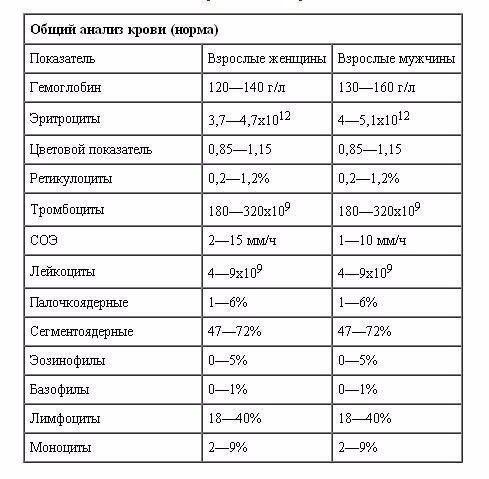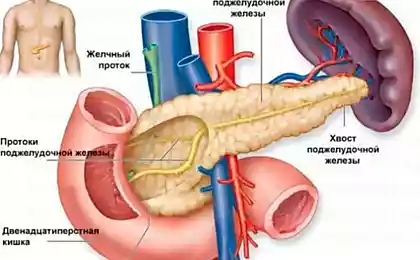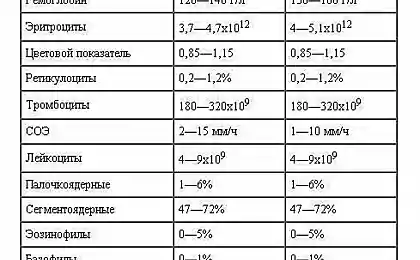465
General analysis of blood is useful to know!
The indicators of the General analysis of blood are (in brackets the abbreviation of indicator):
Hemoglobin (HGB) resides within the erythrocyte protein that is responsible for saturation of the body with oxygen. In the lungs it combines with oxygen and delivers it to the organs. There the oxygen is replaced by carbon dioxide, which is delivered to the lungs. And gas exchange occurs. According to the norms of the General analysis of blood hemoglobin vary for men and women — at first it needs to be higher.
Red blood cells (RBC) — cells that contain hemoglobin. General blood analysis has a graph as "average hemoglobin content in one erythrocyte" (MCH), which reflects the amount of this protein within the erythrocyte.
Hematocrit (HCT) — an indicator of blood viscosity.

Reticulocytes (RE) — young erythrocytes. The fall of hemoglobin and red blood cells below normal may experience with anemia, after a long illness.
Platelets (PLT) provide blood clotting. The overall analysis allows to detect the decrease in platelet count and prevent bleeding that can occur when you fall PLT lower than 50х109/L.
Leukocytes (WBC) are responsible for the immune system. The leukocyte count in the blood test allow you to assess the condition of the immune system and even to determine the cause of the disease. The excess of white cells is often observed in acute bacterial infections, purulent inflammation. The fall in the number of leukocytes below normal probable viral infection, toxic condition, certain bacterial infections.
Thus, if increasing the number of white blood cells fighting a virus — a disease caused by a viral infection, a lot of white blood cells fighting bacteria — a disease of bacterial origin. Treatment in the first and second cases are essentially different.
Against bacteria the most active neutrophils (NE), so when inflammation of the bacterial nature of their percentage in the blood rises. While the number of other types of leukocytes (again expressed in %) is reduced. In sum, the percentage of all types of leukocytes is 100%.
The percentage of different leukocyte types is called leukocyte formula.
A detailed General analysis of blood provides information about the different types of neutrophils. Adult neutrophils, which are pivotal in the fight against infection — are called segmented.
During maturation of the neutrophil goes through several forms: milotic, metamyelocyte, stab neutrophils and segmented then.
Presence of segmented and a small amount of stab neutrophil absolutely fine.
Myelocytes and metamyelocytes appear in severe diseases, mobilization of all forces of the body to fight disease.
Eosinophils (EO) — excess content in the total blood eosinophils is observed in parasitic infestations (e.g., parasitic), allergic reactions, healing from severe bacterial infections.
Basophils (BA) is contained in the blood in small quantities. The increase in the content of basophils found in rare diseases.
Lymphocytes (LYMP) form of General and local immunity. In viral infections the content of lymphocytes is increased.
Monocytes (MON) utilized bacteria, dying cells, and other foreign elements. The increase in the number of monocytes observed in prolonged infections, and infectious mononucleosis.
Plasma cells in healthy adult humans. Appear chickenpox crust, infectious mononucleosis, rubella, certain other viral infections.
An important indicator of complete blood count — erythrocyte sedimentation rate. Inflammation erythrocyte sedimentation rate is increased.
Common blood test you must pass in the morning on an empty stomach.published

P. S. And remember, only by changing their consumption — together we change the world! ©
Join us in Facebook , Vkontakte, Odnoklassniki
Source: vk.com/territoriya_ygasov?w=wall-70157007_20503
Hemoglobin (HGB) resides within the erythrocyte protein that is responsible for saturation of the body with oxygen. In the lungs it combines with oxygen and delivers it to the organs. There the oxygen is replaced by carbon dioxide, which is delivered to the lungs. And gas exchange occurs. According to the norms of the General analysis of blood hemoglobin vary for men and women — at first it needs to be higher.
Red blood cells (RBC) — cells that contain hemoglobin. General blood analysis has a graph as "average hemoglobin content in one erythrocyte" (MCH), which reflects the amount of this protein within the erythrocyte.
Hematocrit (HCT) — an indicator of blood viscosity.

Reticulocytes (RE) — young erythrocytes. The fall of hemoglobin and red blood cells below normal may experience with anemia, after a long illness.
Platelets (PLT) provide blood clotting. The overall analysis allows to detect the decrease in platelet count and prevent bleeding that can occur when you fall PLT lower than 50х109/L.
Leukocytes (WBC) are responsible for the immune system. The leukocyte count in the blood test allow you to assess the condition of the immune system and even to determine the cause of the disease. The excess of white cells is often observed in acute bacterial infections, purulent inflammation. The fall in the number of leukocytes below normal probable viral infection, toxic condition, certain bacterial infections.
Thus, if increasing the number of white blood cells fighting a virus — a disease caused by a viral infection, a lot of white blood cells fighting bacteria — a disease of bacterial origin. Treatment in the first and second cases are essentially different.
Against bacteria the most active neutrophils (NE), so when inflammation of the bacterial nature of their percentage in the blood rises. While the number of other types of leukocytes (again expressed in %) is reduced. In sum, the percentage of all types of leukocytes is 100%.
The percentage of different leukocyte types is called leukocyte formula.
A detailed General analysis of blood provides information about the different types of neutrophils. Adult neutrophils, which are pivotal in the fight against infection — are called segmented.
During maturation of the neutrophil goes through several forms: milotic, metamyelocyte, stab neutrophils and segmented then.
Presence of segmented and a small amount of stab neutrophil absolutely fine.
Myelocytes and metamyelocytes appear in severe diseases, mobilization of all forces of the body to fight disease.
Eosinophils (EO) — excess content in the total blood eosinophils is observed in parasitic infestations (e.g., parasitic), allergic reactions, healing from severe bacterial infections.
Basophils (BA) is contained in the blood in small quantities. The increase in the content of basophils found in rare diseases.
Lymphocytes (LYMP) form of General and local immunity. In viral infections the content of lymphocytes is increased.
Monocytes (MON) utilized bacteria, dying cells, and other foreign elements. The increase in the number of monocytes observed in prolonged infections, and infectious mononucleosis.
Plasma cells in healthy adult humans. Appear chickenpox crust, infectious mononucleosis, rubella, certain other viral infections.
An important indicator of complete blood count — erythrocyte sedimentation rate. Inflammation erythrocyte sedimentation rate is increased.
Common blood test you must pass in the morning on an empty stomach.published

P. S. And remember, only by changing their consumption — together we change the world! ©
Join us in Facebook , Vkontakte, Odnoklassniki
Source: vk.com/territoriya_ygasov?w=wall-70157007_20503























